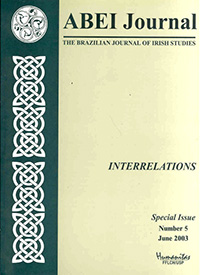The Wild West Show: Ireland in the 1930s
DOI:
https://doi.org/10.37389/abei.v5i1.182368Palavras-chave:
The West of Ireland, cultura irlandesa, literatura irlandesa, artes visuaisResumo
The West of Ireland has played a dignified if supporting role in modern Irish culture. Writers and painters such as Synge, Jack B. Yeats, Sean Keating, Paul Henry, and the Blasket Islanders helped define the (French-inspired) perception of the West as if not sacred then special.In the 1930s, the West was given another make-over under the impetus partly of documentary realism and partly of an interest in a disappearing lifestyle. There was still an appetite for doing something with that western alternative lifestyle, of recuperating its folds for posterity (as with the foundation of the Irish Folklore Commission in 1935), of memorialising its passing (as with the accounts by the last generation of Blasket Islanders), or of using it to make a comment about modernity (as with the Canadian director Robert Flaherty’s documentary film Man of Aran). Man of Aran (1934) is at the centre of several overlapping discourses – visual anthropology, ethnology, documentary film making, Grierson and the 1930s, the ethics of documentarists, and Flaherty’s career as a film maker. Surprisingly, analysis of the film’s place in modern Irish culture has been attended to less frequently, and the critical probing has tended to come from elsewhere. In the Irish context, Man of Aran belongs not so much with Wordworthian Synge but to a body of work that includes most notably Darrell Figgis’s novel Children of Earth (1918) where there is a combination of the forceful naturalism of Zola with Hardy’s sense of place. Synge’s work lives in its language, a language which has a life of its own, conscious of its beauty as well as its fascination for others. In Man of Aran there is almost no dialogue and only occasionally do we hear snatches of conversation. In many ways the most telling Irish critique of Man of Aran remains Denis Johnston’s little-known, satiric play Storm Song (1935). Equally, in terms of visual culture, the contemporary cartoons which appeared in Dublin Opinion should not be overlooked. These provide not only a running satire on the popularisation of the West but also another filter for viewing this body of work, a filter which, given the demise of the West, now seems in many respects closer to the emerging truth.
Referências
Arensberg, Conrad. The Irish Countryman: An Anthropological Study. London: Macmillan, 1937.
Baddeley’s Thorough Guide to Ireland: Part II. London: Thomas Nelson, 1911.
Ballagh, Robert. ‘The Irishness of Irish Art’ (1980) [unpublished lecture], in Luke Gibbons,
Transformations in Irish Culture. Notre Dame/IN: University of Notre Dame Press, 1996.
Bank, Marcus and Howard Morphy (Eds.). Rethinking Visual Anthropology. New Haven/London: Yale
University Press, 1997.
Calder-Marshall, Arthur. The Innocent Eye: a Life of Robert Flaherty. London: W.H. Allen, 1963.
Carbery, Mary. The Farm By Lough Gurr: The Story of Mary Fogarty (Sissy O’Brien). London:
Longmans, Green, 1937.
Collins, Michael. The Path to Freedom. Dublin: Talbot, 1922.
Curtin, Chris; Hastings Donnan; Thomas M. Wilson (Eds.). Irish Urban Cultures. Queen’s University
Belfast: Institute for Irish Studies, 1993.
Delaney, Frank. “Endpiece”. The Listener, 31 May, 1984.
Figgis, Darrell. Children of Earth. Dublin and London: Maunsel, 1918.
Michael, Floyd. The Face of Ireland. London: Batsford, 1937.
Greene, D.H and E.M. Stephens. J. M. Synge 1871-1909. New York: Macmillan, 1959.
Gwynn, Stephen. The Charm of Ireland. London: George Harrap, 1934.
Heaney, Seamus. Introduction to Seamus Heaney: A Personal Selection. Belfast: Ulster Museum, 1982.
Henry, Paul. An Irish Portrait. London: Batsford, 1951.
Hindesight (Exhibition Catalogue). Dublin: Irish Museum of Modern Art, 1993.
Ireland. Dublin: Irish Tourist Association, 1939.
Johnston, Denis. Storm Song and A Bride for the Unicorn. London: Jonathan Cape, 1935.
Johnston, Jennifer. (1984). The Railway Station Man. Harmondsworth: Penguin, 1989.
Kennedy, Brian P.; Raymond Gillespie. Ireland: Art Into History. Dublin/Colorado: Town House/Niwot/
Roberts Rinehart, 1994.
Kennedy, S. B. Irish Art and Modernism. Belfast: Institute of Irish Studies, 1991.
McLoone, Martin. Irish Film: The Emergence of a Contemporary Cinema. London: British Film Institute,
Morton, H. V. In Search of Ireland. London: Methuen, 1930.
O’Malley, Ernie. Army Without Banners. London: New English Library, 1967.
Praeger, Robert Lloyd. The Way That I Went. Dublin/London: Hodges, Figgis & Co./Methuen, 1937.
Robinson, Tim. (1995). Stones of Aran: Labyrinth. Harmondsworth: Penguin, 1997.
Rotha, Paul. Robert J. Flaherty: A Biography (Ed. J. Ruby). Philadelphia: University of Pennsylvania
Press, 1983.
Winston, Brian. Claiming the Real: The Documentary Film Revisited. London: British Film Institute,
Downloads
Publicado
Edição
Seção
Licença
Copyright (c) 2003 David Pierce

Este trabalho está licenciado sob uma licença Creative Commons Attribution-NonCommercial 4.0 International License.


